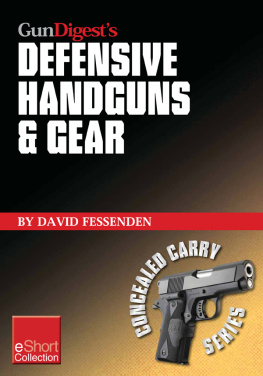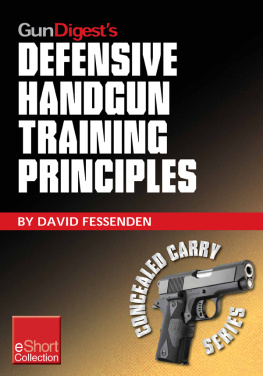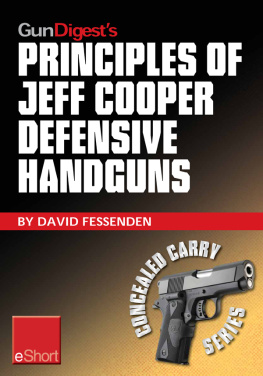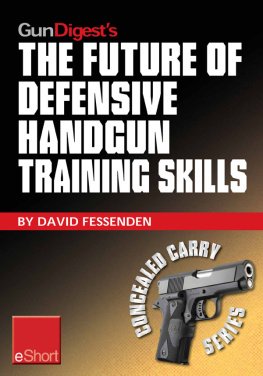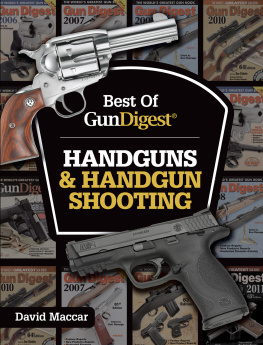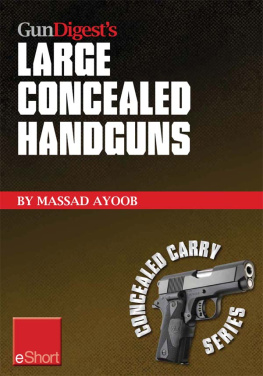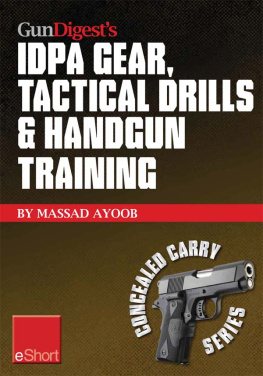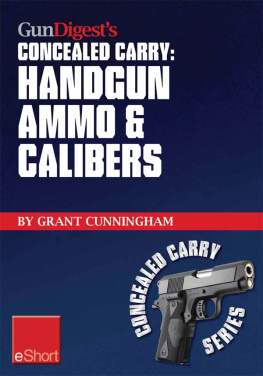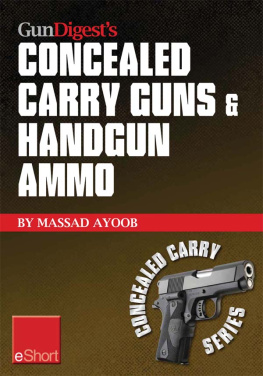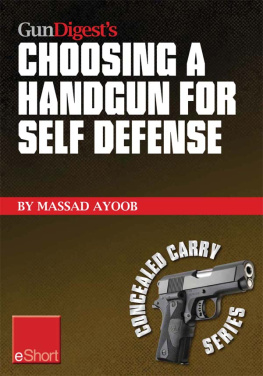David Fessenden - Gun Digests Defensive Handguns & Gear Collection eShort
Here you can read online David Fessenden - Gun Digests Defensive Handguns & Gear Collection eShort full text of the book (entire story) in english for free. Download pdf and epub, get meaning, cover and reviews about this ebook. year: 2012, publisher: F+W Media, genre: Home and family. Description of the work, (preface) as well as reviews are available. Best literature library LitArk.com created for fans of good reading and offers a wide selection of genres:
Romance novel
Science fiction
Adventure
Detective
Science
History
Home and family
Prose
Art
Politics
Computer
Non-fiction
Religion
Business
Children
Humor
Choose a favorite category and find really read worthwhile books. Enjoy immersion in the world of imagination, feel the emotions of the characters or learn something new for yourself, make an fascinating discovery.
- Book:Gun Digests Defensive Handguns & Gear Collection eShort
- Author:
- Publisher:F+W Media
- Genre:
- Year:2012
- Rating:4 / 5
- Favourites:Add to favourites
- Your mark:
- 80
- 1
- 2
- 3
- 4
- 5
Gun Digests Defensive Handguns & Gear Collection eShort: summary, description and annotation
We offer to read an annotation, description, summary or preface (depends on what the author of the book "Gun Digests Defensive Handguns & Gear Collection eShort" wrote himself). If you haven't found the necessary information about the book — write in the comments, we will try to find it.
In this excerpt from Defensive Handgun Skills, David Fessenden covers handgun calibers for concealed carry, revolvers vs. semiautos, CCW holsters, dry practice, live-fire practice, plus loading and unloading the handgun.
Gun Digests Defensive Handguns & Gear Collection eShort — read online for free the complete book (whole text) full work
Below is the text of the book, divided by pages. System saving the place of the last page read, allows you to conveniently read the book "Gun Digests Defensive Handguns & Gear Collection eShort" online for free, without having to search again every time where you left off. Put a bookmark, and you can go to the page where you finished reading at any time.
Font size:
Interval:
Bookmark:

While an excellent choice for recreational shooting, this Smith & Wesson .22 rimfire revolver leaves a lot to be desired as a defensive handgun.
A detailed discussion of this subject would likely cover about several chapters of text, so rather than launch into something of that sort, I will keep it simple.
In my school, we take a bit of time to engage in a brief lecture on many of the weapons, holsters and accessories from which you can select and that will cover the broadest base of common appeal to the average student. We do spend a lot of time on concealed carry equipment, so that those students interested in applying for a permit get a chance to learn about their options in this area.

At the other extreme is the Smith & Wesson Model 640 chambered in .357 Magnum. A perfectly suitable defensive handgun and it shoots the .38 Special cartridge, too!
Small-Bore vs. Big-Bore
For the selection of a concealed carry weapon, many instructors will advise their students to purchase a .22 Long Rifle pistol and train up to a larger caliber firearm. The thinking here is that the student will adjust to the lower noise, recoil and shock of this smaller caliber handgun and will eventually be comfortable enough to move up to the larger caliber pistol with ease.
I view this as a colossal waste of time and money. I prefer to advise my students to bring a .38 Special revolver or 9mm, .40 S&W, .38 Super or .45 ACP semiautomatic to start the class. We teach the student how to properly and safely control and manage the recoil and push of the weapon, even when firing the multiple target drill. This is done with the application of proper stance and grip instruction in an acceptable period of time, usually just a few hours. Students quickly become very confident with their marksmanship and gun handling skills. Any concerns about noise and recoil quickly are forgotten. Ive taught many women without any prior firearms training or experience how to shoot a Glock Model 23 in .40 S&W with ease and precision, and after several hours they have openly thanked me for insisting that they start out with the weapon that will, in all likelihood, end up being their carry weapon.

Smith & Wesson Model 60 single and double action revolver. Chambered for the .38 Special cartridge and built mostly of stainless steel, this is an excellent choice for anyone who wishes to carry a revolver. It can be fired in either single or double action.

Colt Lightweight Commander semiauto pistol with alloy frame, stainless steel slide and 4.25-inch barrel. Chambered for the .38 Super cartridge, this pistol is a compact member of the 1911A1 pistol family and has an exposed hammer. It can be fired single action only.
Revolver or Semiauto?
The first decision you must make is whether to carry a revolver or a semiautomatic pistol. If it is a revolver, select a manufacturer that produces a rugged and reliable double action model. Ruger and Smith & Wesson are excellent selections. Both are top-line companies with numerous high-quality models in .38 Special caliber.
Stay with a stainless steel version. This type of gun resists the formation of surface rust and is easy to clean and maintain. Because you will be carrying the weapon close to your body, under clothing, body heat and perspiration will easily encourage the formation of surface rust on blued firearms. The cleaning of a stainless steel weapon is easy and simple.
Select a 4-inch-barreled model as a compromise between potential accuracy and ease of carry. Depending on the caliber and frame size, the weapon will have a capacity of either five or six rounds. You will want to investigate the need for a speed loader to assist in having extra ammunition capacity and the ability to rapidly reload the weapon.
For the semiautomatic enthusiast, I recommend that you examine any of dozens of models by several manufacturers in the calibers of 9mm, .40 S&W, .38 Super or .45 ACP. Any of the above is more than suitable, provided the shooter uses a cartridge with jacketed hollowpoint or frangible (i.e., easily fragmented) bullet of the type usually referred to as self defense ammunition.
I would recommend that the student limit his or her search and analysis to Glock and any of several 1911A1 type manufacturers: Springfield Armory, Kimber, Para Ordnance, Dan Wesson, Colt and Wilson Combat, just to name a few. Quality, accuracy and reliability is always a consideration in this type of gun, along with price. All of these firearms meet that criterion, but my concern for any concealed carry or duty weapon is that it is very easy to deploy into action. The Glocks and 1911Al meet that need.
The Glock is the easiest of all weapons to operate. It is essentially a point and shoot firearm. Simply load it, point it at your target and press the trigger; it always goes bang! All of the Glocks safety devices are internal and operate off the movement of the trigger mechanism. A new student without prior experience can be quickly brought up to speed with this firearm and become totally comfortable carrying, shooting and operating it.

Chambered for the .40 Smith & Wesson cartridge, the Glock Model 23 is a fairly compact semiauto pistol that can be fired in double action only. It has a polymer frame, 4-inch barrel, no manual safeties and no external hammer.

The Kahr Arms K40 is a compact semiauto pistol that can be fired in double action only. Chambered for the .40 Smith & Wesson cartridge, it has a stainless steel slide and frame, a 3.5-inch barrel, no manual safeties and no external hammer.
The single action 1911A1s are a bit more complex to operate but still offer a good degree of simplicity for the new student. The 1911A1 has two external safety devices: a thumb safety and a grip safety. The thumb safety is located on the upper left side of the frame. The grip safety is a part of the backstrap and is located at the upper rear of the frame. Both of these safeties must be depressed before the weapon will fire.
In many of the late model 1911A1s, several manufacturers have designed and installed into their weapons a passive firing pin safety. It operates off the movement of the trigger and is therefore not a technique that the shooter has to be directly concerned with, other than to be sure that he or she fully depresses the trigger. The firing pin safety simply drops out of the way and allows the firing pin, when struck by the hammer, to move forward and strike the rear face of the primer. I feel that the firing pin safety device is a good feature to have on any semiautomatic pistol. Here again, teaching a new student to safely and correctly fire these weapons is not a major problem for either the student or the instructor in regard to the passive firing pin safety.
Both of these styles of guns come in either 3.5-, 4.25- or 5-inch barrel lengths. If a concealed carry weapon is the objective in your training, I recommend the purchase of a 4.25-inch-barreled Commander-sized model (named after the Colt Commander, the first gun of its type), as a compromise between weight, carry and accuracy objectives. If marksmanship or competition is an objective of the student, then a 5-inch model will serve better.
Font size:
Interval:
Bookmark:
Similar books «Gun Digests Defensive Handguns & Gear Collection eShort»
Look at similar books to Gun Digests Defensive Handguns & Gear Collection eShort. We have selected literature similar in name and meaning in the hope of providing readers with more options to find new, interesting, not yet read works.
Discussion, reviews of the book Gun Digests Defensive Handguns & Gear Collection eShort and just readers' own opinions. Leave your comments, write what you think about the work, its meaning or the main characters. Specify what exactly you liked and what you didn't like, and why you think so.

